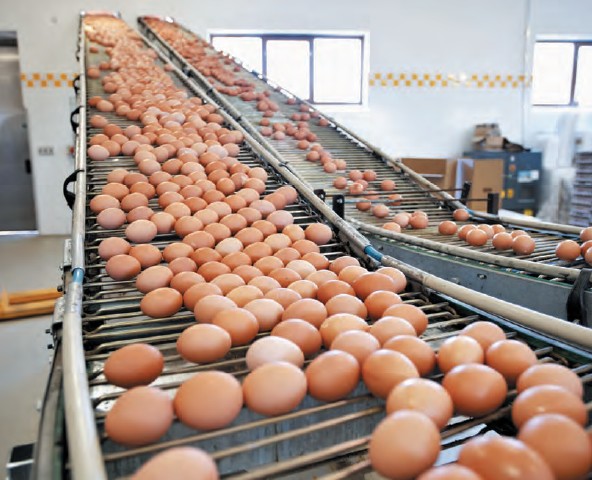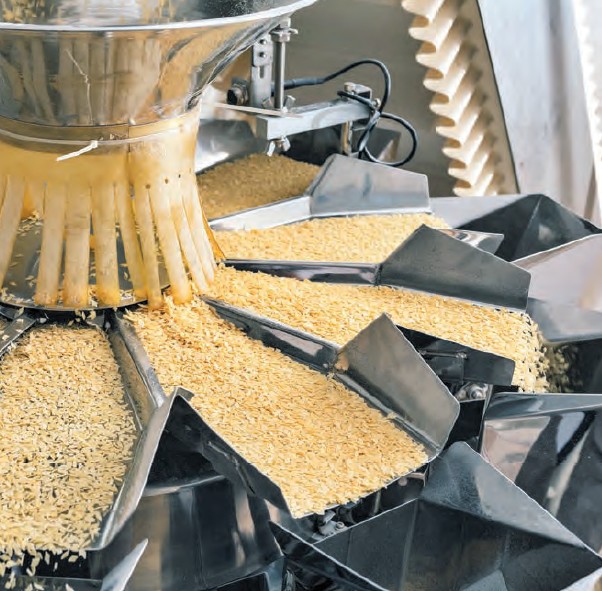Food Processing Machinery
Biz@India
October 2015
The growth of the Indian food processing sector and changing consumer demands coupled with government’s aid to reduce the import duty on machinery, have increased the scope for machinery and equipment.
Many must have heard the success story of 52-yearold Dharamveer Kamboj, a farmer from Haryana, who embarked his journey from being a rickshaw puller to an innovator, only to land as a guest of President of India Pranab Mukherjee at Presidential Palace in New Delhi last year, an honour bestowed on him for his innovation of a multi-purpose food processing machine that can extract juices or essence from herbs swiftly. Kamboj’s machine has a device that is capable of pulverising and extracting oil or gel from various herbs. Consisting of an autoclave unit for sterilisation, a boiler unit for boiling, an extractor unit for extracting juice or gel, the machine can process up to 100 kg of aloe vera in an hour.
A few kilometers away from Kamboj’s village is a food processing machinery unit in Karnal for fruits and vegetables that is deprived of new methods and technology. This naturally hampers the quality of the juices and sausages and further leads to wastage. Karambir Singh, owner of the unit, says, “We face huge wastage due to lack of proper food processing machinery. The machines are too costly. We can’t afford them. Though the demand for processed food is increasing, we lack resources to maintain it.”
The growth in the Indian food processing industry coupled with the recent issues of food quality, safety and hygiene are pushing the demand for more sophisticated machinery and equipment.
Driven by Growth
According to Indian Brand Equity Foundation (IBEF), a trust established by the Indian ministry of commerce as an investment promotion agency to create brand India, the Indian food processing industry accounts for 32 pc of the country’s total food market, 14 pc of manufacturing GDP, 13 pc of India’s exports and 6 pc of total industrial investment. This has led to the requirement of newer methods, technology, and machinery for the food processing industry, with least impact on sensory qualities such as colour and texture. Therefore, technological progress is necessary for the growth of the food processing sector. As per IBEF, in 2013, India imported food processing and packaging machinery worth EUR53 million, which is a plus of 27 pc compared to the same period, the previous year. According to German Engineering Federation, in 2013, out of the total import volume of food processing and packaging machinery from Germany to India (estimated to be EUR132.4 million), the highest share of machinery import was packaging machinery, with a total volume of EUR79.1 million.
Sarang Dongare, director of E&S Food Technologies, says, “In the entire manufacturing segment, food processing constitutes about 9 pc of the output. Hence, the significance of technology cannot be overlooked. From vegetable and fruits to meat and poultry sectors, processing machineries and equipments are needed at every step from farm to fork.” Mumbaibased E&S Food Technologies deals with supply of food processing machinery.
The categories in which the equipment and machinery are more required may differ given the demand by the consumers of the processed food but certainly with the recent health and hygiene practices in the sector, food processors are updating themselves with the latest in the market, Dongare adds.
There are two distinguishing features of food processing machinery, says Vivek Gupta, managing director, Indopol Food Processing Machinery. “If the machinery comes in direct contact with the food product, it must be fabricated from stainless steel, and be free from cracks and crevices that might retain food particles. In those cases, stainless steel surfaces—particularly corners and joints—must be ground to specific ‘smooth’ surface finishes to prevent the retaining of food. The second distinguishing feature of food equipment is very high processing and packaging speeds. This is particularly true of beverage and snack food processing lines.” Snack foods are typically processed and packaged at speeds of more than 100 bags per minute, while beverages are processed at rates of more than 2,000 cans per minute.
Atul Jain, managing director, Dr Froeb (India), mentions, “The demand is driven by the growth this space attained in last one decade, with countries like India having a bulk of young consumers fond of the ready-to-eat food. Also, the ongoing experiment in food that allows a blend of international look and ethnic taste is helping them sail through. Additionally, the intense competition, pricing, capabilities, quality, flexibility, automation features, and after-sales service and support will decide the future of the players manufacturing food processing machinery and equipment.”
Dealing primarily in meat processing machinery and equipment and in the European market, Jain shares, “We represent 90 pc market share in Europe from India. Out of 40 companies, we represent 30 European companies and approximately 3-4 companies from the US. The current scenario is tremendous. Sales have gone double in almost 2-3 years. However the last six months were not so good. But still there is a scope as every year, nearly 3-4 pc people turn non-vegetarians and it is a good sign for us.”
Small, marginal players
In India, the market of food processing industries lies with the small and marginal players. According to a study by auditing firm KPMG on food processing market, 85 pc of the market share is with small players while 8-9 pc is with medium and only 5 pc is with big players. Though the share of small players is major, the issue machinery. Richard Rekhy, associate director – food processing sector at KPMG says, “While the medium and big players mostly have imported critical component required by the processing industry, the small players due to their inability to pay huge bills prefer locally fabricated machines and equipment. Our food processing industry is still in infancy. A lot of hard work is to be done. Nobody is denying the fact that there is a huge opportunity lying but a focussed approach is needed to tap it.”
According to Jain from Dr Froeb (India), the processing equipment manufacturing technology is not developed in India in accordance with the food processing retailing opportunities. Still a large number of specialised equipments are being imported. “We don’t have any specialised manufactures in India unlike in Western countries, where they do immense research on every machinery and equipment.”
Government’s intervention
To overcome the challenge of high cost, the government reduced the customs duty on food processing machinery. Food processing minister Harsimrat Kaur Badal said to a daily, “The government has reduced the duty on specified food processing and packaging machinery from 10 pc to 6 pc. The decision is a step towards capacity building. It is likely to usher investment in the food processing sector and reduce post harvest losses.” The ministry has launched a centrally sponsored scheme of National Mission on Food Processing in 12th Plan (2012-17).
The mission has introduced scheme of technology up gradation/ establishment/ modernisation of food processing industries. Under the scheme, all the eligible small and medium entrepreneurs (SMEs) interested to set up food processing units are provided financial assistance at 25 pc of the cost of plant and machinery.
In addition, all refrigeration machineries and parts used for installation of cold storage, cold room or refrigerated vehicle, for the preservation, storage , transport or processing of agricultural, apiary, horticultural, dairy, poultry, aquatic and marine produce and meat are exempted from excise duty. Kishore Biyani, CEO, Future Group, also shared his view with a daily, “The consumption sector will be a big beneficiary due to the decrease in excise duty on food processing machinery.”
Requirement possibilities
India is expected to witness growth in packaged food, aerated soft drink, packaged drinking water and alcoholic beverage. So there would be a lot of requirement of equipment and machinery. Rekhy from KPMG, however, said that the processing equipment manufacturers of India like L&T, Alfa Laval and SSP, were largely focussing upon milk and dairy, breweries and distilleries not in basic processed food. And state-of-theart technology for other processing purpose is being provided by the foreign industries like Bühler providing critical technology for rice mills, potato mills heat and controlling system. Other companies like Bosch are providing the packaging solutions.”
“Most foreign machinery manufacturers are raring to set up operations in India, including providers of cold chain technologies, advanced processing technologies, commercial kitchen equipment, etc. Such manufacturers must be welcomed and encouraged to set up base. This will help achieve cost and operational efficiency in food processing. However, this should not be done at the cost of domestic machinery suppliers, who also need to be protected,” avers, Dr T Kuchroo, Dr TK Food Consultants, Pavan Srl Italy. The Pavan Group is a provider of process technology solutions to the food industry and automation lines for pasta and golgappas (a popular Indian street food).
As new niche markets emerge and new products are developed to feed consumer appetites, demand for food processing machinery will remain steady, both from the domestic market and international, mainly Europe. “Manufacturers would continue to introduce products to increase convenience and reduce the time required in preparation of meals. Products with additional ingredients, in easy packaging and convenient pack sizes would continue to gain popularity. Advanced technology and the variety of the European products, particularly German, which are optimally tailored to the specific customer requirements, strengthen the economic performance of Indian manufacturers,” concludes Jain.













